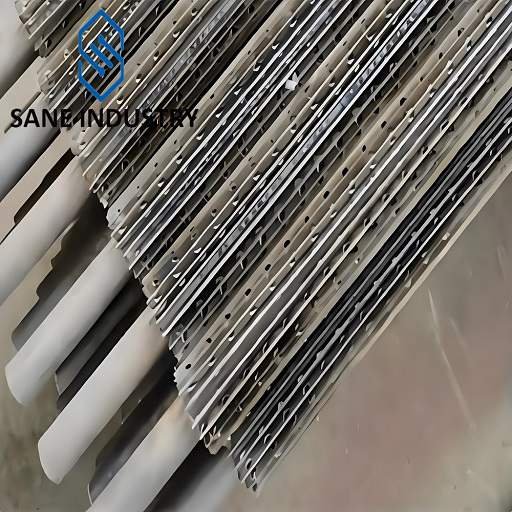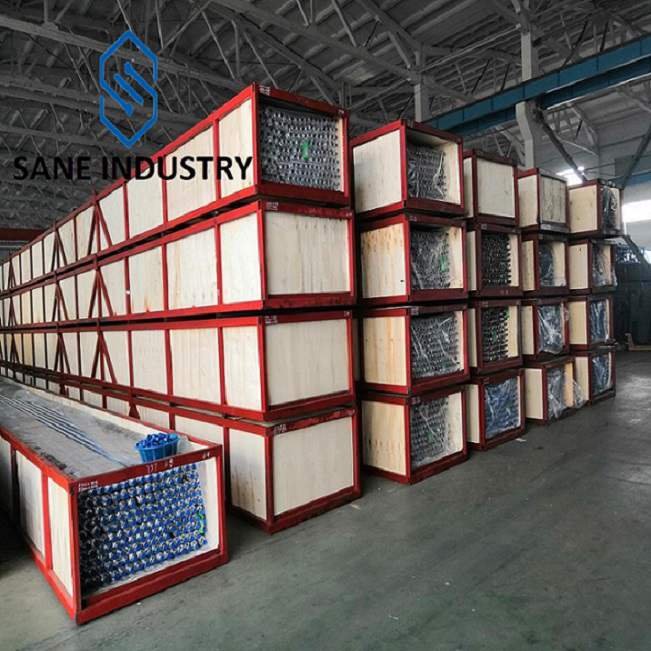What is a Longitudinal Finned Tube
Longitudinal Finned Tubes are produced by resistance welding fins in the longitudinal direction along the length of the tube. The fin strip is first formed into a U-shaped channel, such that each leg of the U will form a fin. The channels are cut to the appropriate length and then oriented along the length of the tube and resistance welded in place. The channels are welded in pairs, diametrically opposed, therefore the number of fins specified must always be a multiple of four.
The Manufacturing Process of Longitudinal Finned Tubes
Material Preparation
- Base Tube: Carbon steel, stainless steel, or alloy tubes are selected based on thermal and mechanical requirements.
- Fin Strips: Thin metal strips (aluminum, copper, or steel alloys) are precision-cut to ensure uniform dimensions.
Fin Attachment
- Fins are aligned axially along the tube surface and welded using high-frequency currents, creating metallurgical bonds with tensile strength of 150–500 MPa.
The Advantages of Longitudinal Finned Tubes
Enhanced Heat Transfer
- Fins increase surface area, boosting thermal efficiency by 30–45% in applications like boilers and condensers.
Compact Design
- High surface-to-volume ratio reduces equipment size, ideal for space-constrained systems (e.g., HVAC, chemical reactors).
Material Versatility
- Compatible with carbon steel, stainless steel, or aluminum, supporting temperatures up to 600°C and corrosive environments.
Structural Durability
- Welded fins resist vibration, thermal fatigue, and mechanical stress (lifespan: 15–25 years with coatings).
Energy & Cost Savings
- Reduces energy consumption in heat recovery systems by 20–35%, offsetting higher initial costs over time.
The Disadvantages of Longitudinal Finned Tubes
Higher Initial Cost
- Complex manufacturing increases upfront expenses vs. smooth tubes.
Fouling Susceptibility
- Narrow fin gaps trap particulates or deposits, reducing thermal efficiency by 10–25% in dusty/contaminated environments.
Maintenance Challenges
- Cleaning fins requires specialized tools (e.g., high-pressure jets), raising operational downtime and costs.
Limited Fluid Compatibility
- Poor performance with high-viscosity fluids (e.g., heavy oils) due to restricted flow between fins.
Pressure Drop
- Fins disrupt fluid flow, increasing resistance by 15–30% in gas/liquid systems.
Weight & Bulk
- Additional fin material adds 20–50% weight, complicating installation in lightweight structures.
Thermal Stress Risks
- Mismatched thermal expansion between fins and base tube may cause warping (>400°C).
Sizes and Materials of Our Longitudinal Finned Tubes
| Base Tube Diameter | 16 to 350 mm | 3/8″ to 14″ NPS |
| Base Tube Wall Thickness | 2.11 to 25.4 mm | 0.08″ to 1″ |
| Base Tube Length | ≤32,000 mm | ≤92 ft |
| Base Tube Material | Carbon Steel (A106B, P235GH, A179, A210, A192, etc.) Alloy Steel (P5, T5, P9, T9, T11, T22, etc.) Stainless Steel (TP304, TP316, TP347, B407 800H/HT, etc.) | |
| Fin Pitch | 2U to 60U | 2U to 60U |
| Fin Height | 5 to 31.75 mm | 0.19″ to 1.25″ |
| Fin Thickness | 0.5 to 1.5 mm | 0.02″ to 0.06″ |
| Fin Material | Carbon Steel, 2.25Cr-1Mo, 5Cr-0.5Mo, 11-13Cr (409, 410), 18Cr-8Ni (SS 304), 25Cr-20Ni | |
| Fin Type | U | |
For other customized requirements, please contact us.
Our Production Capacity of Longitudinal Finned Tubes
Total two longitudinal fin tube machines, monthly production capacity is 50 tons in total.
Longitudinal Finned Tubes Uses
Steam Generation Systems
- Used in boilers for efficient heat transfer in petrochemical plants and power plants, leveraging axial alignment for stable high-temperature performance.
Air-Cooled Heat Exchangers
- Ideal for HVAC and industrial cooling, where compact fin spacing maximizes surface area for air-to-fluid heat exchange.
Exhaust Gas Heat Recovery
- Captures waste heat from gas turbines or engines, benefiting from vibration-resistant design in turbulent flow conditions.
Process Heating (Oil & Gas)
- Heats low-viscosity fluids (e.g., natural gas, light oils) in refineries, avoiding fouling risks in controlled environments.
Solar Thermal Systems
- Enhances energy absorption in concentrated solar receivers due to durable fin-tube bonding under thermal cycling.
Aerospace Thermal Management
- Manages heat dissipation in aircraft engines, where lightweight yet robust finned tubes withstand mechanical stress.
Comparison Longitudinal Finned Tubes to Other Finned Tubes
| Feature | Longitudinal Finned Tubes | Helical Finned Tubes | Extruded Finned Tubes |
|---|---|---|---|
| Fin Design | Axially aligned fins (5–25mm height) | Spiral-wound fins (continuous) | Fins extruded from base tube |
| Manufacturing Method | High-frequency/laser welding | Spiral winding + welding | Mechanical extrusion |
| Thermal Efficiency | +30–45% vs. smooth tubes | +40–60% (high surface area) | Moderate (limited height) |
| Fluid Compatibility | Limited for high-viscosity fluids | Better for gases | Corrosion-resistant (aluminum) |
| Maintenance | Prone to fouling; requires cleaning | Easier cleaning (spiral flow) | Low (integral fins) |
| Cost | Higher initial cost (welding) | Moderate | Lower (extrusion process) |
| Key Applications | Petrochemical boilers, HVAC | Power plant exchangers | Refrigeration, low-corrosion |
Why Choose Us
- a 16-year longitudinal fin tube manufacturer. We are experts.
- solutions for all your needs
- the highest product quality
- the low lead times
- excellent customer service








